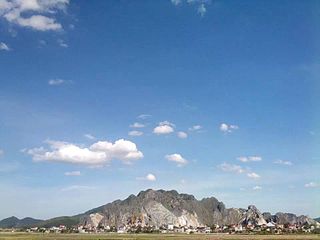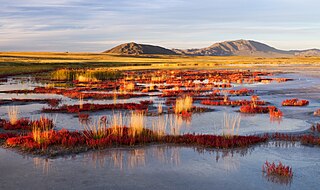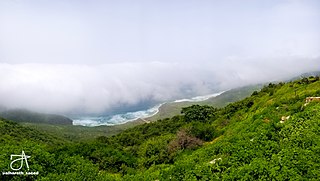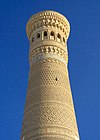Related Research Articles

A World Heritage Site is a landmark or area with legal protection by an international convention administered by the United Nations Educational, Scientific and Cultural Organization (UNESCO). World Heritage Sites are designated by UNESCO for having cultural, historical, scientific or other form of significance. The sites are judged to contain "cultural and natural heritage around the world considered to be of outstanding value to humanity".

Zabid is a town with an urban population of around 52,590 people on Yemen's western coastal plain. It is one of the oldest towns in Yemen, and has been a UNESCO World Heritage Site since 1993; though, in 2000, the site was placed on the List of World Heritage in Danger.

Sabratha, in the Zawiya District of Libya, was the westernmost of the ancient "three cities" of Roman Tripolis, alongside Oea and Leptis Magna. From 2001 to 2007 it was the capital of the former Sabratha wa Sorman District. It lies on the Mediterranean coast about 70 km (43 mi) west of modern Tripoli. The extant archaeological site was inscribed as a UNESCO World Heritage Site in 1982.

Nisa was an ancient settlement of the Parthians, located near the Bagyr neighborhood of Ashgabat, Turkmenistan, 18 km west of the city center. Nisa is described by some as the first seat of the Arsacid Empire. It is traditionally assumed to have been founded by Arsaces I and was reputedly the royal residence of the Parthian kings, although it has not been established that the fortress at Nisa was either a royal residence or a mausoleum.

The Sikhote-Alin is a mountain range in Primorsky and Khabarovsk Krais, Russia, extending about 900 kilometres (560 mi) to the northeast of the Russian Pacific seaport of Vladivostok. The highest summits are Tordoki Yani at 2,077 metres (6,814 ft) above sea level, Ko Mountain (2,003 m) in Khabarovsk Krai and Anik Mountain (1,933 m) in Primorsky Krai.

The Xiangkhouang Plateau or Xiangkhoang Plateau, also known in French as Plateau du Tran-Ninh is a plateau in the north of Laos. The landscape is characterized by green mountains, rugged karst formations and verdant valleys with plenty of rivers, caves and waterfalls.

Avroman or Hawraman, is a mountainous region located within the provinces of Kurdistan and Kermanshah in western Iran and in north-eastern Kurdistan Region in Iraq. The main part of the Hawraman region is located in Iran and encompasses two components of the Central-Eastern Valley ; and the Western Valley. The mode of human habitation in these two valleys has been adapted over millennia to the rough mountainous environment. Tiered steep-slope planning and architecture, gardening on dry-stone terraces, livestock breeding, and seasonal vertical migration are among the distinctive features of the local culture and life of the semi-nomadic Hawrami Kurdish people who dwell in lowlands and highlands during different seasons of each year. On July 27, 2021, part of the Hawraman region along with Uramanat were inscribed on the UNESCO World Heritage List as a cultural site under the name "Cultural Landscape of Hawraman/Uramanat".

The Acacus Mountains or Tadrart Akakus form a mountain range in the desert of the Ghat District in western Libya, part of the Sahara. They are situated east of the city of Ghat, Libya, and stretch north from the border with Algeria, about 100 kilometres (62 mi). The area has a particularly rich array of prehistoric rock art.

Vĩnh Lộc is a rural district of Thanh Hóa Province in the North Central Coast region of Vietnam. As of 2003 the district had a population of 87,219. The district covers an area of 157 km². The district capital lies at Vĩnh Lộc. The village is famous for the Citadel of the Hồ, a short-lived Vietnamese Dynasty (1400-1407), Hồ Quy, the founder of the Dynasty, having built the Citadel in 1397 and moved the capital there in 1401. Since 2011, the Citadel is part of UNESCO World Heritage Sites.

Uvs Lake Basin is an endorheic basin located on the territorial border of Mongolia and Tuva, a republic of the Russian Federation. The basin is part of the Central Asian Internal Drainage Basin and is named after Uvs Lake, a large saline lake situated in the western part of its drainage basin and is one of the last remnants of the mammoth steppes. Uvs Lake is a shallow lake with an area of 3,350 km2 (1,290 sq mi). Its entire basin, which includes several smaller lakes, is 70,000 km2 (27,000 sq mi).

Ancient and Primeval Beech Forests of the Carpathians and Other Regions of Europe is a transnational serial nature UNESCO World Heritage Site, encompassing 94 component parts (forests) in 18 European countries.
Ahsikent is a site of ancient settlement and ancient capital of Farghona (Fergana). It is located on the right branch of the Sirdarya River in the Turakurgan district of the Namangan region of Uzbekistan. It is currently under consideration for designation as a UNESCO World Heritage Site.
Shahrukhiya is a site of ancient settlement located 88 km to the southwest of Tashkent, Uzbekistan, on the right coast of Syrdarya River. It is the first large city of the Tashkent oases, situated on the Great Silk Road through Yaksart (Syrdarya). In the oriental sources, it was famous under the name Benaket, and the portion of the Great Silk Road direction called by its name.

The Palace of Shaki Khans in Shaki, Azerbaijan was a summer residence for the Shaki Khans. It was built in 1797 by Muhammed Hasan Khan. The palace was intended to house the Khans who were in charge of controlling Sheki, as viceroys of the ruling Zand and later Qajar Persian dynasties around 1750 until the time when these territories were annexed by the Russian Empire per treaty of Gulistan in 1813 after the Russo-Persian War (1804–1813).

Hawf District is a district of the Al Mahrah Governorate, Yemen. As of 2003, the district had a population of 5,143 inhabitants. The Hawf Area was nomination to be a natural UNESCO World Heritage Site in August 2002. Current the status is listed as tentatively approved.
Istlada was a town of ancient Lycia; the name is known only from inscriptions and is uncertain because the end of the inscription has been lost.

The Khorezm Fortresses, or Elliq Qala in Uzbek, are a collection of more than 50 desert fortresses in Karakalpakstan and the Khorezm Region of Uzbekistan. They are included on UNESCO’s Tentative List for World Heritage Site status as the Desert Castles of Ancient Khorezm.
References
- 1 2 Ancient Pap - UNESCO World Heritage Centre Retrieved 24 March 2009.
Coordinates: 40°50′N71°02′E / 40.833°N 71.033°E
